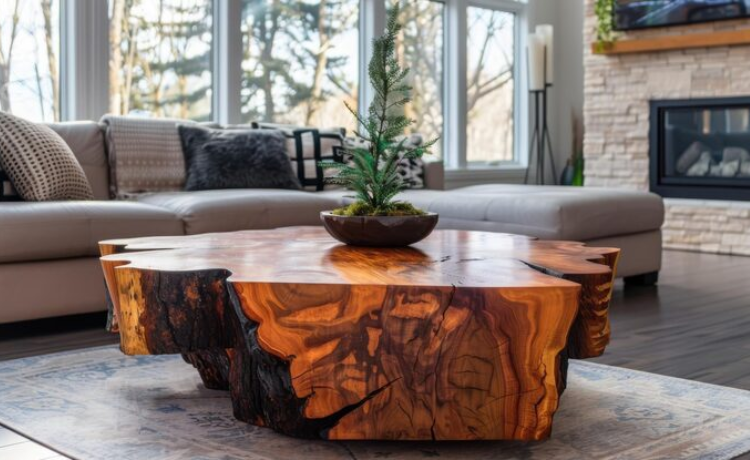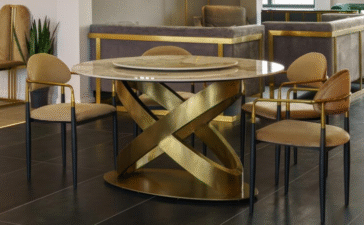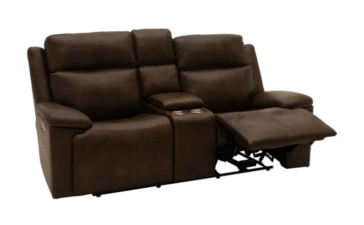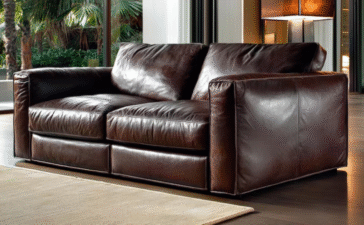Modern interior design often feels like a battle between sleek minimalism and the desire for warmth. We want clean lines, but we also crave comfort and connection. This is exactly why live edge wood has surged in popularity over the last decade. It bridges the gap between the raw beauty of nature and the functional requirements of a contemporary home. A live edge table acts as a grounding element in a room. Whether you are looking to anchor a dining room or add a conversation starter to your living area, custom live edge furniture offers an aesthetic that mass-produced pieces simply cannot match. This style of modern rustic décor celebrates the imperfections of the material, turning knots, cracks, and wandering grain patterns into features rather than flaws.
What Is a Live Edge Table?
The term live edge refers to the craftsmanship style where the woodworker incorporates the natural edge of the tree into the design of the piece. Unlike standard lumber, which is cut into straight, uniform lines, a natural wood table retains the organic shape of the tree from which it was cut.
The bark is typically removed to prevent peeling and to allow for a smooth finish, but the natural curve, gnarled texture, and unique silhouette remain. This results in an organic edge design that follows the tree’s life history. These pieces are often referred to as a slab table because they are frequently constructed from a single, massive slice of a log. The result is a piece of furniture that feels alive and dynamic, serving as a direct link to the forest it came from.
The Enduring Benefits of Live Edge Tables
The primary draw for most homeowners is the undeniable aesthetic appeal. A live edge table brings instant warmth and character to a space. The visual complexity of the grain patterns and the soft, wandering lines of the edge create a focal point that softens the hard angles often found in modern architecture. It transforms a simple dining area into a gallery of nature.
Sustainability plays a massive role in the decision to buy these pieces. Many craftsmen prioritize using reclaimed wood or trees that were felled due to illness or storm damage. Because the design celebrates the “flaws” of the tree, wood that might be rejected by a standard lumber mill becomes the star of the show in sustainable furniture. This approach reduces waste and ensures that the tree is honored in its second life as a functional object.
Durability and uniqueness are also significant factors. When properly sealed and maintained, handcrafted tables made from hardwoods can last for generations. They are heavy, solid, and resistant to the wear and tear of daily life. Furthermore, because no two trees are identical, every single unique wood table is a one-of-a-kind creation. You will never walk into a neighbor’s house and see the exact same table.
Materials Used in Live Edge Design
The species of wood chosen dramatically impacts the final look of the table. Black walnut is perhaps the most coveted option for a live edge walnut table due to its rich, dark tones and striking contrast between the heartwood and the lighter sapwood at the edges. Maple offers a lighter, more subtle aesthetic, often with rippled grain patterns known as “curly” or “tiger” maple. Oak provides a traditional, robust feel with prominent grain, while cedar offers a reddish hue and aromatic quality, though it is softer and better suited for coffee tables than dining surfaces.
Modern woodworking has also introduced the epoxy resin table. This technique involves taking two slabs of live edge wood and inverting them so the live edges face each other, filling the gap between them with colored or clear epoxy. This creates a “river” effect that is incredibly popular in contemporary design.
Customization is central to this style. A custom live edge dining table allows you to select the specific slab that speaks to you. You might choose a piece with dramatic “figuring” (the pattern of the wood grain) or deep cracks that are stabilized with contrasting wooden bowties, adding yet another layer of visual interest.
Choosing the Right Live Edge Table for Your Space
Selecting a live edge dining table requires more thought than buying a standard rectangular table. You must consider the available space carefully. Because live edge tables have irregular widths—narrower at one end and wider at the other—you need to measure your room to ensure there is adequate clearance for chairs and walkways around the widest point of the slab.
You also need to determine how the table fits your style. A dark, heavy slab with iron legs fits perfectly into an industrial loft or a farmhouse setting. Conversely, a lighter wood like ash or maple with sleek, mid-century modern legs works beautifully in modern live edge furniture layouts.
Consider the function as well. If you are designing a home office, a custom live edge table design can serve as an inspiring desk. However, you must ensure the writing surface is flat enough for your needs. For a dining table, deep cracks or voids might need to be filled with clear resin to prevent crumbs from collecting, ensuring the table is practical for daily meals.
How Live Edge Tables Are Made
The creation of handcrafted wood tables is a labor-intensive process that honors the material. It begins with sourcing and drying the wood. The drying process is critical; large slabs must be kiln-dried to a specific moisture content to prevent warping or twisting later on. Once dried, the woodworker uses specialized woodworking techniques to flatten the slab, a difficult task given the size and hardness of the material.
The bark is carefully removed by hand using drawknives and chisels to preserve the underlying live edge without damaging it. The surface is then sanded through progressively finer grits to reveal the depth of the grain. If the wood has natural splits, the craftsman may insert “butterflies” or “keys”—small pieces of wood shaped like a bowtie across the crack to prevent it from spreading.
Finally, the finish is applied. This is often a blend of natural oils and waxes or a durable polyurethane, depending on the desired level of protection. Custom live edge tables are often finished to a satin sheen rather than a high gloss. Which keeps the wood looking natural and touchable.
Caring for Your Live Edge Table
Proper maintenance is essential to protect your investment. Wood is a hygroscopic material, meaning it reacts to moisture and temperature changes in its environment. To ensure live edge table protection, keep your home’s humidity levels relatively consistent. Avoid placing the table directly over a heating vent or in direct sunlight. Which can cause the wood to fade or crack over time.
For daily cleaning, use a soft, damp cloth and mild soap. Avoid harsh chemical cleaners that can strip the finish. Wood care tips almost always emphasize the use of coasters and placemats. While hardwoods are tough, they can still be stained by red wine or scorched by a hot pan.
Refinishing wood furniture of this caliber is an option if the surface becomes scratched or dull after years of use. If the table has an oil finish, you may simply need to reapply a coat of oil every year or two. If it has a film finish like lacquer or polyurethane, a professional can sand it back and respray it, making the table look brand new again.
Styling Your Live Edge Table
Styling a live edge table is about balance. Because the table itself is so visually heavy and textured, you often want to keep the surrounding elements simpler. In a dining room, consider pairing a heavy slab table with sleek, modern chairs to create a striking contrast. This mix of old and new is a hallmark of modern rustic home décor.
Lighting is crucial. A linear chandelier hanging above the table can illuminate the grain patterns and the edge profile. When it comes to tabletop décor, less is often more. A simple ceramic vase with fresh greenery or a linen runner is often enough. You do not want to cover up the beautiful wood you paid for.
For live edge dining room ideas, look to nature for color inspiration. Earth tones, soft greens, and warm neutrals on the walls and in rugs will complement the wood tones without competing with them.
Also Check: “furniture table round“
Where to Buy Live Edge Tables
Finding the right piece involves deciding between convenience and customization. You can buy live edge tables from some high-end furniture retailers, but these are often mass-produced using veneers or glued-up boards rather than solid slabs.
For a truly authentic piece, look for a custom live edge furniture maker or a local artisan. These craftspeople can walk you through the slab selection process, allowing you to choose the exact piece of wood that will become your table. They can customize the dimensions, the leg style, and the finish to your exact specifications.
When searching for a live edge table near me, check local maker directories or visit craft fairs. Prices will vary significantly based on the size of the slab and the rarity of the wood. Expect to pay a premium for single-slab tables compared to “book-matched” tables (two slabs joined together), but remember that you are purchasing a piece of art that will hold its value.
Conclusion
Investing in a live edge table is a commitment to quality, history, and nature. These pieces offer a unique combination of durability and artistry that is rare in the furniture world. By understanding the materials, the craftsmanship, and the care required. You can choose a table that will serve as the gathering place for your family for decades to come.
Whether you are drawn to the deep chocolate tones of walnut or the rustic charm of oak, live edge furniture investment is one that pays off in daily enjoyment. It is eco-friendly home décor that tells a story.
Ready to find the perfect centerpiece for your home? Visit our website today to explore our curated collection of ethically sourced slabs and start designing your custom table.
Frequently Asked Questions (FAQ)
How much does a live edge table cost?
The live edge table price varies widely depending on the wood species, the size of the slab, and the complexity of the base. A small coffee table might start around $500, while a large, single-slab black walnut dining table can easily range from $3,000 to over $10,000. Custom epoxy resin tables or rare wood species will typically command a higher price due to the labor and material costs involved.
How can I make my live edge table last longer?
To ensure live edge table longevity, consistency is key. Keep your home at a stable temperature and humidity level to prevent warping. Always use coasters for drinks and trivets for hot dishes to prevent rings and heat marks. Dust regularly with a microfiber cloth and re-oil the surface annually if your table has an oil finish. Treating the wood with respect will ensure it remains an heirloom piece.
What’s the difference between a live edge table and a regular wood table?
The main difference in live edge vs wood table comparisons is the edge profile. A regular wood table has edges that have been cut straight and squared off by a machine. A live edge table retains the natural, irregular curve of the tree trunk along its sides. Additionally, live edge tables are often made from solid, single slabs of wood. Whereas standard tables are frequently glued together from multiple smaller boards.












